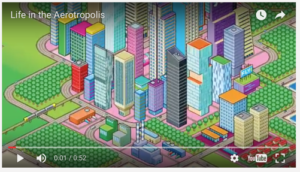Aug 01, 2016
What Makes an Aerotropolis?
“That sounds interesting, but what does it mean?” is the question that most commonly follows someone’s first intruduction to the word “Aerotropolis”. The idea behind this Jestons-esque name is crucial in understanding the future of development here in Southeast Michigan and beyond. The concept was popularized by Dr. John D. Kasarda in the early 2000s, but the word Aerotropolis first appears in 1939 edition of Popular Science magazine, alongside a drawing of rooftop runways.
Dr. Kasarda’s work revolves around the idea that airports will be the focal point of economic development since historically, access to the fastest form of transport available fostered growth of cities at those points. This idea also flows into the concept that those regions with better airports and corresponding services will outpace competitive regions in development as geography becomes less and less important in a globalized world. An applied example being places such as Kansas City which leveraged growth out of the Transcontinental Railroad in the early 20th century, and Detroit who is currently taking advantage of its world class commercial and cargo airports to foster growth in this century.
Of course, an Aerotropolis does not imply that air travel will make all other forms of travel obsolete. Existing and future transportation infrastructure built around an Aerotropolis are a critical pillar of success. Dr. Kasarda consulted on the initial development of the Detroit Region Aerotropolis and one of the pieces that made our region a perfect fit for this initiative was the existing interstate and railways near Detroit Metro and Willow Run. Airports serve as the hub, but the idea cannot move forward without the crucial spokes of other multimodal infrastructure.
How Can an Aerotropolis Serve Industry?
The Detroit Region Aerotropolis’ focus is on development in transportation, distribution, logistics, manufacturing, and R&D. These tend be the obvious points of development when discussing aerotropoli, however that is far from the complete story.
An aerotropolis will increase quality of life by attracting jobs that are on the forefront of industry. Despite the clichéd use of phrases like “smart jobs” and “new economy”, an aerotropolis is where you see exactly these types of companies and employees. Why? Success in growing industries, from robotics to health care requires talent and speed-to-market. An aerotropolis is the ideal place for both a corporate headquarters and a distribution center.
What happens when new tech jobs become old tech jobs? When innovation makes a particular good or service obsolete, the new product, company, or industry will still need the talented employees and access-to-market of an aerotropolis. This sustainability is what has taken this futuristic word and idea from a pre-WWII drawing to successful strategy for building a regional economy.



